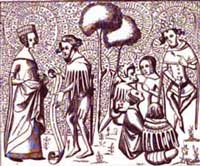Court of Love
The history of the Court of Love can be studied using the works of authorities like Andreas Capellanus, the 12th century author who wrote De Amore, and the poet Martial d’Auvergne (1420 - 1508).

A Court of Love in Provence - 14th Century
Besides these authors, the poems of the troubadours bear testimony to the existence of these courts. The Court of Love is mentioned as early as the time of William of Poitou, the first troubadour whose works have been preserved.
Of these courts, the most celebrated were those of Eleanor of Aquitaine, of the ladies of Gascony, of the Viscountess of Narbonne, of the Countess of Champagne, and of the Countess of Flanders. The first three, the most celebrated, were in the English dominions. They exercised a wide jurisdiction over the neighbouring districts, and to them were also submitted the disputes of the English troubadours and their lady-loves. There were also several courts in Provence, the most famous being those of Pierrefeu, Signe, Romanin, and Avignon.
The lyric poems of dispute, the tensons, frequently mention the courts, which were supposed to solve differendums in a loyal and honest manner.
According to Jean de Nostredame, the younger brother of Michel de Nostredame, the tensons were disputes on points of love between troubadours and ladies. “In this,” he notes, “if they could not come to an agreement, they referred the matter for decision to the illustrious lady presidents who held open and plenary court at the Castle of Signs, and other places, and these gave judgments which were called the judgments of Love.”
In such castles, the most celebrated, accomplished, and beautiful ladies formed tribunals of judgment. They deliberated and passed sentence according to the usages of love. Nostredame declares that he saw the sentences of some of these tribunals written in magnificent books of vellum.
The object of the Court of Love was to legislate on all questions regarding love, to settle disputes between lovers, to pass sentence on any lover who was in the wrong, and generally to establish a system of jurisprudence, which would be useful in solving problems which might arise between lovers, thus leaving the tribunals only as a last resort.
How a court of love was constituted
The rule was that all the ladies who composed the courts should be married or widows. The names of the ladies who judged at some of these courts have been preserved. The lists of the courts of Romanin, Avignon and elsewhere show that nearly all the ladies who acted as judges were married ladies. /
In the court of the ladies of Romanin there was only one name of an unmarried lady, Hugonne de Sabran, daughter of the Comte de Forcalquier. In the court of the ladies of Pierrefeu perhaps one name may likewise be supposed to be that of a spinster.
Another principle of selection was that they should belong to the high noblesse of their district. At Pierrefeu, the majority of the ladies were the wives or widows of feudal seigneurs, while a countess, a viscountess, and the daughter of a count were found in the ranks of the jurors.
It appears that there was no exact regulation regarding the number of ladies in a court of love. Regarding that of the Countess of Champagne, we read of “a very large number of ladies.” On special occasions, the number could be very high. No less than sixty ladies are mentioned as having met to consider an important case connected with a lady’s behaviour to a nobleman of rank. As a general estimate, the number of ladies in the court ranged from ten to sixty, and most of the time was probably of an average of these numbers.
The court of love was not always composed exclusively of ladies. Upon request, as in the case of the troubadour Guillaume de Bergedan, the trial could be held by the seigneur of the district, who pronounced the decree necessary “with the advice of his council,” composed of gentlemen like himself. But such cases were exceptions, and the general rule requested that the judges be chosen from the ladies of the district, with one of them appointed the president.
A court of love took its name from the leading lady, who was the highest authority, and we know of the Court of Eleanor of Aquitaine, the Court of the Countess of Champagne, and so on.
Method of procedure
To obtain the verdict, the complete assent of all the ladies present was necessary. We hear of a dispute judged by the court of the ladies of Gascony, which was “resolved, with the assent of the whole court.” The leading lady of the district had to summon a sufficient number of ladies who were specially chosen for the function, and were the recognized members of the court. Once the court of love was appointed, the ladies met to hear the complaint made and the cause pleaded in due form before them.
To conclude, the court of love tried to legislate upon all questions concerned with what was at the time a subject of culture, art, and elegance: love.

